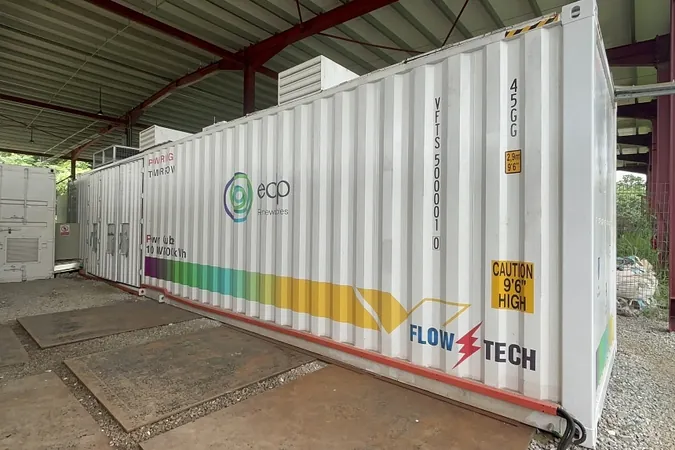
How Giant Batteries are Revolutionizing Solar Energy Storage in Singapore
2024-10-23
Author: Sarah
Singapore is harnessing the power of the sun like never before in its quest for renewable energy, and giant batteries play a crucial role in this transformative journey. As the country looks to maximize its limited solar energy sources, advances in energy storage technology are becoming essential to capturing and utilizing excess energy generated during sunlit days.
Energy storage systems (ESS)—often referred to as giant batteries—are crucial for this mission. These systems function like massive energy reservoirs, storing electricity for peak demand times or when the sun isn’t shining. Recently, the Energy Market Authority (EMA) has allocated $7.8 million in grants to two innovative companies working on next-generation ESS technology. This funding seeks to break new ground—by exploring underground installations to save valuable land space and experimenting with alternative battery types.
What Are Energy Storage Systems?
Primarily based on lithium-ion technology, these energy storage systems capture electricity generated from solar panels during the day, particularly when production exceeds consumption. When night falls or energy demand spikes, the stored electricity is discharged for use. This dual-functionality not only helps meet consumption needs but also provides backup power during outages.
The International Energy Agency anticipates that global battery storage capacity will nearly triple by 2030, underscoring the importance of energy storage for sustainable development.
According to Dr. Wesley Zheng, chief executive of Posh Electric (one of the grant recipients), while ESS presents remarkable opportunities, upfront costs remain a significant barrier. A one-megawatt hour (MWh) system, for instance, can range from $450,000 to $800,000, with payback periods stretching between seven to ten years.
Current Developments in Singapore's ESS Landscape
Singapore isn’t just conceptualizing energy storage; it’s actively deploying systems of various scales across the nation. The largest installation is located on Jurong Island, boasting over 800 large-scale battery units covering two hectares. Deployed by Sembcorp Industries in 2023, this system has a staggering capacity of 285MWh, sufficient to power around 24,000 four-room HDB flats for an entire day with a single discharge.
During the Singapore International Energy Week conference, Deputy Prime Minister Gan Kim Yong revealed ongoing talks between EMA and Sembcorp to further expand the Jurong Island facilities. Enhancements to this system are planned, including stacking existing ESS units and integrating next-generation batteries that can store double the energy of current models.
Another revolutionary entry into the ESS sphere is VFlowTech, the second beneficiary of the grants. Their system, situated on Pulau Ubin, can discharge 50 kilowatts of electricity continuously for 24 hours, significantly cutting down the island’s reliance on diesel by nearly 100,000 liters annually. Remarkably, VFlowTech uses a safer metal called vanadium instead of lithium, which minimizes fire risks associated with conventional lithium-ion batteries.
On October 22, VFlowTech further solidified its commitment to sustainable energy by partnering with Advario Asia Pacific and JTC Corporation to upscale its vanadium flow batteries, repurposing existing oil tanks on Jurong Island for this new technology. This innovative system is projected to be fully operational by 2024, turning industrial waste into a resource for renewable energy storage.
The Future is Bright
As Singapore continues to innovate in green technology and address its energy challenges, the role of energy storage systems has never been more critical. With advancements in ESS technology paving the way for efficient solar energy utilization, the nation is positioning itself as a leader in renewable energy adoption. The commitment to creating a sustainable energy future is not just beneficial for Singapore but serves as a global model in the fight against climate change.
Stay tuned, as these developments could change the energy landscape forever!


 Brasil (PT)
Brasil (PT)
 Canada (EN)
Canada (EN)
 Chile (ES)
Chile (ES)
 España (ES)
España (ES)
 France (FR)
France (FR)
 Hong Kong (EN)
Hong Kong (EN)
 Italia (IT)
Italia (IT)
 日本 (JA)
日本 (JA)
 Magyarország (HU)
Magyarország (HU)
 Norge (NO)
Norge (NO)
 Polska (PL)
Polska (PL)
 Schweiz (DE)
Schweiz (DE)
 Singapore (EN)
Singapore (EN)
 Sverige (SV)
Sverige (SV)
 Suomi (FI)
Suomi (FI)
 Türkiye (TR)
Türkiye (TR)